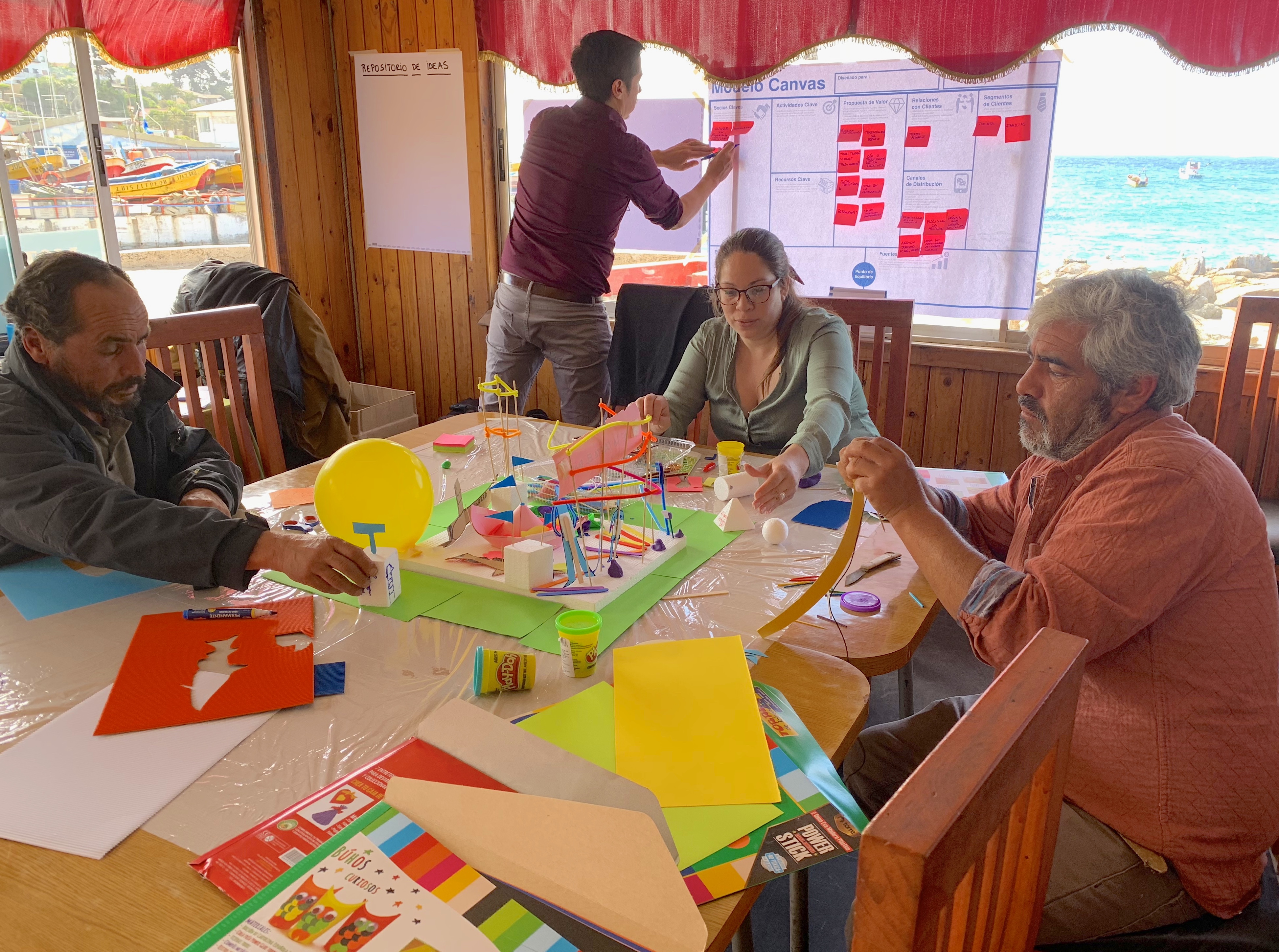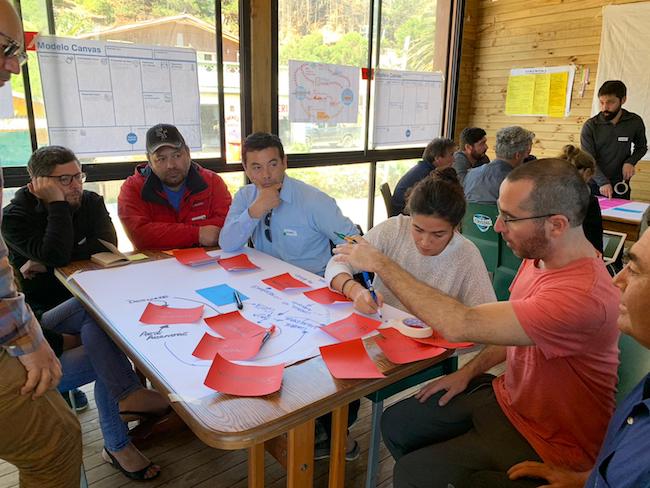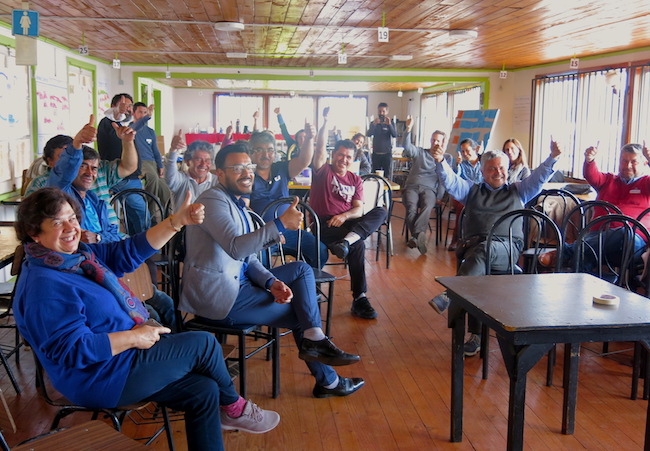
by Iván Greco, Research Associate at FOF
The last time we reported from our on the ground process, we told you about the characteristics of each Caleta with whom we embarked with on this adventure (blog: On the ground in Chile: Caleta Profile).
During the months of October and November, we helped to create the space for co-design to occur, and with our partners we conducted 7 workshops across 4 caletas. These were spaces where we rolled out the red carpet for creativity and innovation, and allowed thinking, idea development, and business plan skeletons to emerge: all approaches or ways to improve aspects of the sustainability of the fisheries (mainly hake) that members of the syndicates are embedded in.
Here we briefly summarize the experience and the outcomes.
San Antonio:

El Quisco:
The idea of establishing a cooperative and getting cold storage capacity to stabilize prices and sell in an associative way is already happening in the syndicate, and should be further developed. As in San Antonio, this idea tries to tackle the unfair low prices that persist despite the good quality of the hake. The co-design also surfaced many ideas about potential buyers, together with creating a brand that reflects the history of the syndicate. The process of exploiting the potential for productive diversification and / or creating a processing plant for hake and other alternative resources were also identified as activities for the cooperative to handle. Many ideas, and a lot of raw material — synonymous to a lot of work ahead of us. We are simply delighted!

Duao:
San Pedro de Concón:
Their fishers, led by their president Julieta, know that they can improve their income and be less stressed out "if there is professional work and dedication in the core of the group". It was with that fresh mindset that the co-design was framed in this caleta, complimented by a diverse group of stakeholders. Among this group there is a fixed idea: they must diversify towards a resource that is abundant, even if this means learning new processes. The new species of choice is Jaiba (crab), and possibly other attractive species like benthics and species like Reineta (pomfret) or Congrio (conger). The atmosphere of the location makes these ideas more sophisticated and attractive: It is necessary to focus on the visiting tourists, who, like in many other caletas on the coast of the V region, approach in large numbers. The goal is to be able to offer quality products. Here the existing processing facility and the addition of a sales room take great importance. Being able to upgrade the existing processing facilities in order to process crab, and being able to sell the product in thermal bags to meet the constant influx of visitors were some of the new colors that the creativity rainbow offered that afternoon. Taking advantage of the proximity of San Pedro to other places in the area with good potential sales was another aspect to consider. The logistics and distribution can be controlled by the syndicate.
The skeletons of these business models are in the oven as you read these lines. It is time to process them within our team, to think about the ideal funding sources that would correspond to each of them, and to start the process of making these ideas a reality. That's what the work of the coming months will be about. Stay tuned!
Hacia Adelante, ideas co-diseñadas
by Iván Greco, Research Associate at FOF
La última vez que les comentamos del proceso, les explicamos sobre las características de cada Caleta junto a las que iniciamos esta hermosa aventura (blog: Desde el llano en Chile: Perfil de las caletas).
Durante los meses de Octubre y Noviembre, ayudamos a crear espacios para el co-diseño; junto a nuestrxs socixs en Chile, condujimos 7 talleres con las 4 caletas con las que estamos trabajando: espacios de encuentro en las caletas donde la creatividad e innovación ayudan a pensar ideas y esqueletos de planes de negocio para mejorar aspectos relacionados a la sostenibilidad de las pesquerías (principalmente de merluza común) de los socios miembro de los Sindicatos con los que trabajamos.
Aquí les resumimos brevemente la experiencia.
San Antonio:
El Quisco:
La idea de cooperativizarse y conseguir capacidad de almacenamiento en frío para estabilizar los precios y vender en forma asociativa ya está rodando en el Sindicato. Como en San Antonio, esto ataca lo que se refiere a los injustos precios bajos (pese a la buena calidad de la merluza). Muchos ideas sobre potenciales compradores aparecieron entre lxs participantes de los co-diseños. Crear una marca propia que refleje la historia del sindicato puede ser la estrategia adecuada para materializar la idea. Anexarle a dicha marca la historia de la caleta le dio balance a la misma junto con la idea de explotar el potencial de diversificación productiva y/o crear una planta de procesamiento para la merluza y los recursos alternativos. Muchas ideas, mucho material… sinónimo de mucho trabajo por delante…Nosotrxs deleitadxs!
Duao:
San Pedro de Concón:
Sus pescadores, liderados por su presidenta Julieta, saben que pueden mejorar sus ingresos y estar más tranquilos “si hay trabajo profesional y dedicación en el medio”. Teñido de esos aires fue que se trabajó en esta caleta el co-diseño junto con un grupo diverso de actores. Entre los pescadores hay una idea fija: hay que diversificar hacia un recurso que abunda y del que ellos están dispuestos a aprender e innovar: La Jaiba. Hay otras especies atractivas: bentónicos y especies como Reineta o Congrio. La atmósfera del lugar hizo que se sofisticara la idea: Hay que enfocarse en los turistas visitantes, que al igual que muchas caletas en la costa de la V región de Valparaíso, se acercan en grandes cantidades. La meta es poder ofrecer productos de calidad. Aquí la existente sala de procesamiento y de ventas cobran un gran valor. Mejorar los procesos de la misma para poder procesar jaiba y poder vender con bolsas térmicas a los visitantes fueron algunas de los nuevos colores que el arcoíris de creatividad arrojó esa tarde. Aprovechar la cercanía de San Pedro a otros lugares de la zona con buenas ventas potenciales, fue otro aspecto a considerar. La logística y distribución puede ser controlada por el sindicato.
Los esqueletos de estos modelos de negocio están en el horno mientras Ud lee estas líneas. Es hora de correr los mismos, pensar las ideales fuentes de financiamiento que le corresponderían a cada uno. De eso se trata el trabajo de estos meses. Hasta la próxima!




